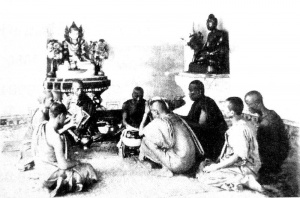Upasampada
Upasampadā (Pali) literally means "approaching or nearing the ascetic tradition." In more common parlance it specifically refers to the rite of ordination by which one undertakes the Buddhist monastic life.[1]
According to Buddhist monastic codes (Vinaya), a person must be 20 years old in order to become a monk or nun. A person under the age of 20 years cannot undertake upasampada (i.e., become a monk (bhikkhu) or nun (bhikkhuni)), but can become a novice (m. samanera, f. samaneri). (To see how a person sets out to gain upasampada, see pabbajja or "adopting the condition of mendicancy.") After a year or at the age of 20, a novice will be considered for the upasampada.[2]
Certain organizations may require a person to practice in a semi-renounced state for a set period of time for the sake of preparation and cultural familiarization.
The strictures surrounding upasampada are different for samaneras and samaneris.
Traditionally, the upasampada ritual is performed within a well demarcated and consecrated area called sima (sima malaka) and needs to be attended by a specified number of monks - "ten or even five in a remoter area" (Peter Skilling, How Buddhism invented Asia, 2009).[3]
Footnotes
- ↑ Rhys Davids & Stede (1921-25), p. 147, article on "Upasampadā" (retrieved 26 Sep 2007 at http://dsal.uchicago.edu/cgi-bin/philologic/getobject.pl?c.0:1:3930.pali).
- ↑ Encyclopædia Britannica (2007).
- ↑ Peter Skilling, How Buddhism invented Asia, 2 April 2009. Peter Skilling interviewed by Phillip Adams. Online audio recording.
